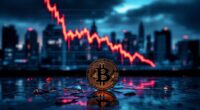The digital asset hovers near its 50-day moving average, a technical indicator that fundamentally tells us the market can’t decide whether to throw a party or a pity party. This indecision comes despite Ripple’s legal victory over the SEC, which removed a cloud that had been raining on XRP’s parade for years.
Looking at the forecast, experts predict XRP’s 2025 trading range between $1.82 and $4.41, averaging around $2.95. Some optimistic analysts even project 15% monthly growth, potentially pushing XRP toward $20 by mid-2026. That’s like predicting your houseplant might grow into a redwood—possible, but requiring some extraordinary circumstances.
The recent legal clarity has certainly attracted institutional interest, like bees to a newly-bloomed flower. The coin’s peak price of $2.76 reached in mid-February showcases investor optimism despite recent volatility. With a market cap of $102.8 billion and circulating supply exceeding 58 billion tokens, XRP commands significant presence in the cryptocurrency ecosystem. Ripple’s RLUSD stablecoin launch adds another potential boost to market confidence.
But volume loopholes—sudden gaps between trading activity and price movement—could signal trouble ahead. While XRP lacks the privacy features that have made certain competing cryptocurrencies targets for regulatory scrutiny, this transparency may actually work in its favor as regulations tighten.
Technical analysis reveals a bullish W-pattern that suggests testing new all-time highs, with Elliott Wave analysis predicting a Wave 5 breakout to $3.00. If you’re not familiar with Elliott Waves, think of them as the crypto market’s mood swings documented in chart form.
Of particular concern is the prediction of a potential false breakout causing a flash crash to $1.60–$1.40 before recovery. That’s the “sabotage” part of the equation—when volume patterns create deceptive signals that can trap unwary investors.
XRP faces critical resistance at $2.50 and $2.76, with strong support at $2.03. Breaking above $2.50 could send it toward $3.00, while failure might mean retesting the psychological $2.00 barrier—a number that matters simply because humans like round figures.









